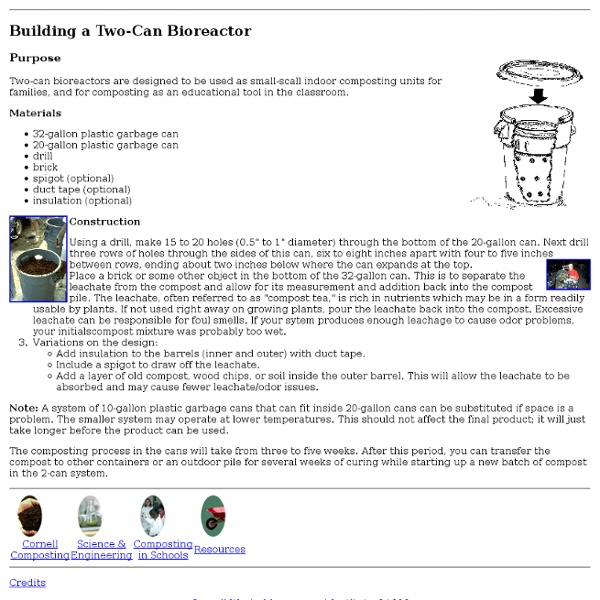



http://compost.css.cornell.edu/garbagecans.html
Composting: A timetable Everyone knows that composting your fruit and vegetable scraps and other biological material is much better than sending those scraps to the city dump, where they would turn into methane gas. But one thing people usually don't consider when starting a compost pile is how long it will take to turn into ripe compost. Here is a simple guide to give you an idea of how long it will take, using different composting methods. Hot Turn: 20 Days
5 Secrets to a ‘No-work’ Garden It took over 20 years of gardening to realize that I didn’t have to work so hard to achieve a fruitful harvest. As the limitless energy of my youth gradually gave way to the physical realities of mid-life, the slow accretion of experience eventually led to an awareness that less work can result in greater crop yields. Inspired in part by Masanobu Fukuoka’s book, One Straw Revolution, my family experimented with gardening methods which could increase yields with less effort. Fukuoka spent over three decades perfecting his so-called “do-nothing” technique: commonsense, sustainable practices that all but eliminate the use of pesticides, fertilizer, tillage, and perhaps most significantly, wasteful effort. Here are the strategies we used which enabled us to greatly increase our garden yield, while requiring less time and less work. 1.
The Humanure Handbook - Build your own humanure toilet! HUMANURE HANDBOOKCenter of the Humanure Universe Compost toilets can provide a sanitation solution when water or electricity are not available, or when you simply want to make more compost or less environmental pollution. Buy a Loveable Loo Online. Make Your Own Compost Toilet PDF E-Book - Amazon - Kindle - Barnes and Noble Book Stores: Order from our distributor: Chelsea Green Publishing. Compost in 18 Days - Iceweasel Compost in 18 Days: The Berkley MethodBy Douglas Barnes We all know that compost is an excellent fertilizer for plants. It is also a sensible way to deal with organic wastes.
Druid Tree Lore Trees in particular were mysterious, and seemed to me direct embodiments of the incomprehensible meaning of life. For that reason, the woods were the place that I felt closest to its deepest meaning and to its awe-inspiring workings. C.G.Jung, Memories, Dreams, Reflections Druids love trees and often visit trees and woods to meditate there, hold ceremonies, or simply commune with Nature. Fertilizer Friday Composting IV It's Friday, and that means a visit to Fertilizer Friday over at Tootsie Time.Check out her blog party and see what other people have blooming in their gardens. This is my fourth post in my series about Composting. You can read the others here: Composting I -What is Compost? Composting II -Getting Started Composting III -What to Compost
Hot Compost – Composting in 18 Days « Deep Green Permaculture - Iceweasel Regular composting, also known as “cold composting”, involves placing a variety of organic materials in a compost bin, enclosure, or even just in a large heap, and leaving it there until it breaks down several months later. It’s a very slow process and typically takes 6 to 12 months. It can be sped up by turning the compost, that is, moving around the material at the bottom of the heap to the top and vice versa to mix it up and get more oxygen in there, but it’s still a long wait. The other approach to composting is “hot composting”, which produces compost in a much shorter time.
Grow your own herb garden - Tantalize your taste buds with fresh herbs - Herb Gardening - Gardens Tantalize your taste buds with fresh herbs You don't need a garden plot to keep yourself supplied with fresh herbs all summer long. A sunny location, some soil, pots and a bit of care can turn a balcony, staircase, deck, patio or window into a private produce department. While mint and rosemary are best grown in individual containers, you can pack a smorgasbord of various herbs into a window box.
Microbial Life - Educational Resources Teaching and learning about the diversity, ecology and evolution of the microbial world; discover the connections between microbial life, the history of the earth and our dependence on micro-organisms. The expansive Sunset Lake of the Black Sand Basin is one of the largest thermal bodies of water in Yellowstone National Park. Details This site contains a variety of educational and supporting materials for students and teachers of microbiology.
How to Build a Tumbling Composter: 11 steps (with pictures) Edit Article Edited by Tom Stricker, James Quirk, Tom Viren, Sondra C and 28 others One of the keys to composting is aeration. The bacteria need oxygen to carry out the aerobic respiration that creates rich compost. Herbalism guide - growing and using your own herbs The hands-on herbalism guide begins! Welcome to the main page of my herbalism guide. One of the subjects I hope to be covering on the Container Gardening For Food website is that of Herbs and Herbalism - mainly because I've taken up herbalism as a hobby. During future growing season, I intend to dedicate some of my small garden to growing herbs, and hope to be writing articles and making videos as I go.